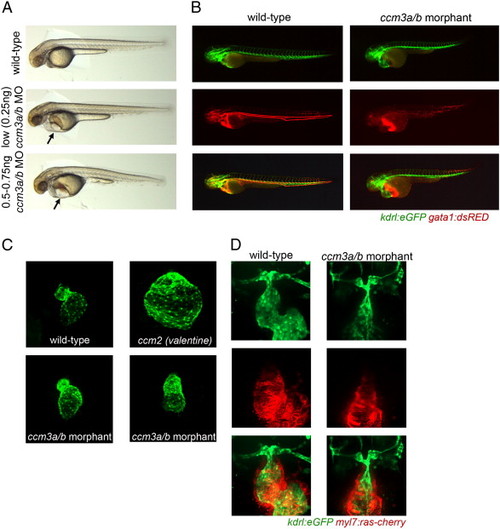Fig. 1
|
Morpholino knockdown of ccm3a/b in zebrafish embryos causes cardiovascular defects distinct from ccm1/2 mutants. (A) Light images of ccm3a/b morpholino injected embryos at 54 hpf. Morphant embryos display a severe pericardial edema and complete circulatory block, but no gross morphological defects when injected with 0.25–0.75 ng ccm3a/b ATG morpholino. (B) Fluorescent microscopy images of ccm3a/b morpholino injected and non-injected double transgenic kdrl:EGFP; gata1:dsRED embryos at 54 hpf. Morphants lack circulation with blood pooling at the yolk. (C) Confocal images of the ccm3a/b morpholino injected Tg(myl7:EGFP)twu34 wildtype and ccm2 (valentine) mutant embryos. At 54 hpf, ccm3a/b morphant hearts are dysmorphic but not enlarged, unlike the ccm2 (valentine) mutants whose hearts appear grossly dilated. (D) Confocal images of ccm3a/b morpholino injected and non-injected double transgenic kdrl:EGFP, myl7:ras-cherry embryos. Injection of morpholino causes thinning of the ventral aorta and the first aortic arches by 54 hpf. |
| Genes: | |
|---|---|
| Fish: | |
| Knockdown Reagent: | |
| Anatomical Terms: | |
| Stage: | Long-pec |
| Fish: | |
|---|---|
| Knockdown Reagent: | |
| Observed In: | |
| Stage: | Long-pec |
Reprinted from Developmental Biology, 362(2), Yoruk, B., Gillers, B.S., Chi, N.C., and Scott, I.C., Ccm3 functions in a manner distinct from Ccm1 and Ccm2 in a zebrafish model of CCM vascular disease, 121-131, Copyright (2012) with permission from Elsevier. Full text @ Dev. Biol.

